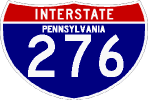
Pennsylvania Turnpike

Pennsylvania Turnpike
One of four Interstate which comprise the Pennsylvania Turnpike system, which after the Western Extension opened in 1951, was the next logical expansion. A 33-mile section from the Valley Forge exit to Bristol and a proposed crossing of the Delaware River there would be necessary. With a bridge, travelers could access the New Jersey Turnpike, thus making it possible to travel from New York City to the Ohio line. In May and June of 1951, Governor John S. Fine signed a bill to construct the Delaware River Extension and a joint toll bridge with the New Jersey Turnpike.
Everything seemed fine; however, there was a problem. The 1948 indenture under which the Philadelphia and Western Extensions were financed allowed additional expansions. The problem was work could not start on a new extension until the previous project was open to traffic for two years, which would mean waiting until 1954 to begin financing. Governor Fine signed a bill in August of 1951 creating a new financing instrument, the Indenture of September 1, 1952. It was a supplement to the 1948 indenture and was intended to facilitate all future expansion.
To finance the Delaware River Extension, the PTC issued $65 million worth of bonds in September of 1952. The configuration at the Valley Forge interchange had to be converted from a terminus to an "off-line" interchange. It was built to connect to a future highway that would connect the Turnpike to Philadelphia: the Schuylkill Expressway. Construction started in 1952 with the ground breaking on November 20.
The 1,224-foot-long bridge over the Schuylkill River was the longest structure on the extension. On August 23, 1954, the Delaware River Extension opened to the Norristown and Willow Grove interchanges. The remaining interchanges opened as follows: Fort Washington on September 20, Philadelphia on October 27, Delaware Valley on November 17.
While the celebration of the opening was taking place, the Pennsylvania Turnpike Commission was not only looking to building the Delaware River Bridge but also a spur to Scranton. In 1954, the commission combined the financing of both projects into one $233 million bond.
Ground was broken for the bridge on June 22, 1954. It was constructed and jointly financed by the New Jersey Turnpike Authority and the Pennsylvania Turnpike Commission. It cost $27,200,000 and opened on May 23, 1956 at 11:30 AM when Governors George M. Leader of Pennsylvania and Robert B. Meyner of New Jersey met in the middle of the span to cut the ribbon. The bridge is 135 feet above the Delaware River because of the ship traffic that utilizes the river. The significance of the bridge is that it would soon be possible to travel between Maine and the Indiana-Ohio border (and soon to Chicago with the completion of the Indiana East-West Toll Road) without encountering a traffic light, cross street, or grade crossing.
Originally designated as Interstate 280, the number changed in 1963 when Interstate 76 replaced Interstate 80S. With that change came the current Interstate 276 designation.
This highway has the distinction of being where the first Act 61 project began. Act 61 is in plain English the Turnpike Organization, Expansion, and Toll Road Conversion Act which was passed in September 1985 by the state legislature. On March 10, 1986, work began to widen the highway from the Northeast Extension to the Philadelphia Interchange from four lanes to six to accommodate the increased traffic. The $120 million project was finished on November 23, 1987. Improvements to the Fort Washington, Willow Grove, and Philadelphia Interchanges preceded the widening.
In late 1989, ground was broken on the Mid-County Interchange in Plymouth Township, Montgomery County. This project included the largest contract awarded by the Pennsylvania Turnpike Commission. The interchange is the largest in the system and the first additional interchange on the mainline to be constructed since completion of the Scranton Interchange on the Northeast Extension in 1957. The interchange has the largest toll plaza with 17 lanes for entering and exiting traffic and eight ramps comprising 4.4 miles. The Mid-County and Norristown interchanges are connected via a fiber optic cable which permits data sharing between the toll plazas and the main office in Harrisburg.
A $55 million general construction contract was awarded to the Hull Corporation of Syracuse, New York in late 1989. This included construction of the toll plaza, utility building, roadway, structures, signing, and lighting.
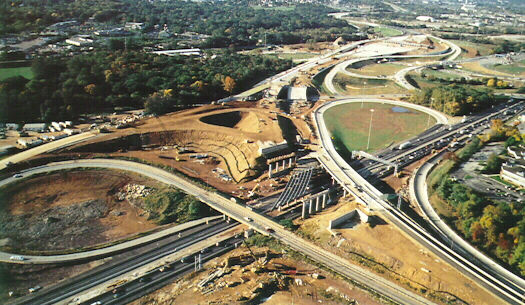
Mid-County Interchange under construction. The old Northeast Extension
interchange bridge is in the foreground. (Pennsylvania Turnpike Commission)
In 1990, the PTC awarded contracts totaling $131,000 to the Hull Corporation for heating, ventilation, and air conditioning. Thomas M. Durkin and Sons' contracted to handle wetland replacement totaling $316,097.
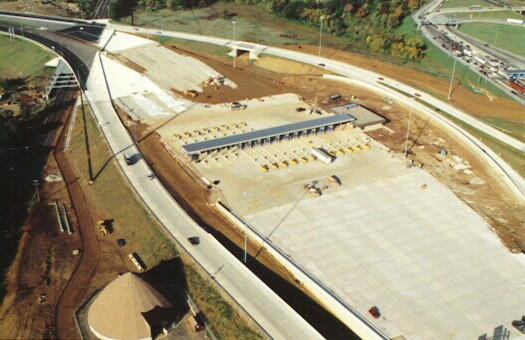
The new 17 lane toll plaza. The ramps on the edges of the picture
are for
the Germantown Pike interchange. (Pennsylvania Turnpike Commission)
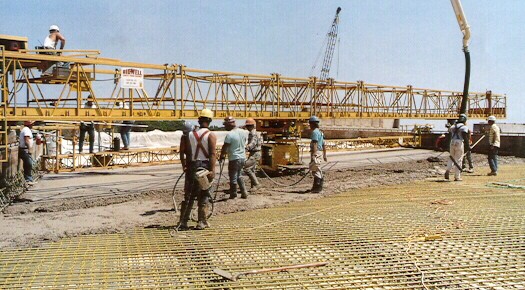
Workers pouring concrete for the deck of the
new southbound bridge.
(Pennsylvania Turnpike Commission)
Since the construction took place in a highly developed area of suburban Philadelphia where there are many active roadways, maintaining a smooth traffic flow posed a challenge. To prevent problems, the project was divided into phases and stages. The purposes of this was to maintain at least four lanes of traffic on the mainline Turnpike and to provide access to the Northeast Extension while the ramps are under construction. Solution cavities posed an even greater problem to the construction. These are formed when groundwater has worn away earth between limestone rocks, thus creating an underground cavern. To guarantee that the bridge supports at the south end of the culvert for the Plymouth Creek sat on firm ground, an addition $400,000 was needed. This paid for extra excavation and concrete work. A concrete grout mixture was pumped underneath and around the bottom of the bridge pilings required an additional $350,000. On December 15, 1992, the first interchange on the Turnpike to have "fly over" ramps opened to traffic.
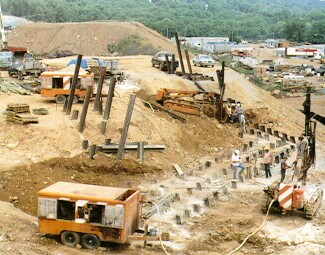
Grout being pumped into underground voids.
(Pennsylvania Turnpike Commission)
A massive pothole opened up on the Delaware River Bridge on July 8, 1998. It took days to fix, and while repairs were made, traffic had to be diverted off the bridge.
In January 1999, the PTC began a feasibility study on widening the highway from the Valley Forge interchange to the Norristown interchange. The entire project, including widening work on the Northeast Extension, will cost approximately $200 million. Work was already underway to widen the existing bridge over the Schuylkill River which began in spring 1997 and wrapped up in June 1999. Widening the highway to six lanes will begin in 2003.
E-ZPass, an electronic toll collection system, was unveiled on December 2, 2000 on the entire stretch of I-276. This system is, or will be, used for toll collection on every toll highway and bridge in the Northeast. It was only available to personal automobiles for the initial unveiling and expanded to include commercial vehicles on December 14, 2002.
With the implementation of the E-ZPass system, the PTC was able to open its first two slip ramps at Virginia Drive at the Fort Washington Office Center Park. The interchange is the first unmanned exit, and first to be numbered using mileage-based exit numbers, on the mainline Turnpike, utilizing only the E-ZPass system to charge tolls for vehicles entering or exiting the westbound Turnpike. Construction of the ramps began in early 2000. Additional slip ramps are being planned along the Turnpike near large businesses or corporate parks, to allow drivers to enter or exit the highway closer to their workplace.
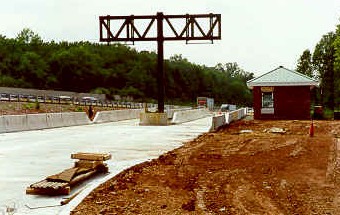
The new Virginia Drive/E-ZPass only exit.
(Pennsylvania Turnpike Commission)
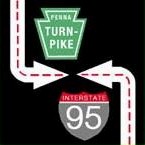 The
completion of Interstate 95 between Philadelphia to New York City is inching
ever closer with construction of the I-95/PA Turnpike interchange. Upon
completion, I-276 will end at another Interstate rather than disappearing at the
Pennsylvania/New Jersey border. Until the late 1960s, I-95 followed the US
13 alignment in the area. It would have provided a direct connection to
the Turnpike, but because of environmental reasons the Interstate could not be
built north of the Turnpike. After cancellation of the Somerset Freeway in
New Jersey, the Turnpike Commission was tasked in 1985 with creating a
connector. The original plan would have taken 150 homes and cut through
Delhaas Woods to build the connecting ramps, but the plan had changed by 1999 to
only require the taking of 10 homes and sparing the woods entirely.
The
completion of Interstate 95 between Philadelphia to New York City is inching
ever closer with construction of the I-95/PA Turnpike interchange. Upon
completion, I-276 will end at another Interstate rather than disappearing at the
Pennsylvania/New Jersey border. Until the late 1960s, I-95 followed the US
13 alignment in the area. It would have provided a direct connection to
the Turnpike, but because of environmental reasons the Interstate could not be
built north of the Turnpike. After cancellation of the Somerset Freeway in
New Jersey, the Turnpike Commission was tasked in 1985 with creating a
connector. The original plan would have taken 150 homes and cut through
Delhaas Woods to build the connecting ramps, but the plan had changed by 1999 to
only require the taking of 10 homes and sparing the woods entirely.
Stage One involved building a high-speed interchange between the Pennsylvania Turnpike and Interstate 95, a new mainline toll plaza, and widening the Turnpike from Exit 351 to the Delaware River. Stage Two will involve constructing a parallel span across the Delaware River south of the existing span. The following were the plans for the new toll plaza, interchange, and bridge:
|
|
|
|
|
|
On January 6, 2004, the US Department of Transportation approved the environmental impact study. "Late 2007" was the "optimistic forecast" for groundbreaking for the first part, a new toll plaza, said PTC spokeswoman Christina Hampton after the announcement was made. The North Neshaminy Service Plaza was closed on May 12, 2010 and replacement of overpasses along I-276 at Bristol-Oxford Valley Road and Galloway Road began October 25 and November 15, 2010 respectively as part of this project. The new $9.7 million overpasses opened to traffic on November 4, 2011.
An unusual financing scheme to complete the interchange came to light in April 2013. Foreign investors, primarily from China, would infuse the project with $200 million, and in turn, they would get green cards for themselves and their families. The deal involves creating a new limited partnership called the Delaware Valley Regional Center Pennsylvania Turnpike L.P., with an office in Berwyn, that would have to be approved as a US Citizenship and Immigration Service designated "regional center" to recruit foreign investors with which to provide the Turnpike Commission the loan. On April 26, the PTC signed a $200 million loan agreement with the limited partnership. Federal law permits the dealmakers to go immediately to China, or elsewhere, to begin recruiting investors, but they can not accept funds until approval. Despite some success around the country with these type of partnerships, the Immigrant Investor Program has drawn criticism for lax oversight and dubious projects that have not produced domestic jobs nor permanent green cards for foreign investors.
PTC CEO Mark Compton joined Governor Tom Corbett and Lieutenant Governor Cawley as well as federal, state, and local officials at the Trevose Maintenance Facility, where the mainline toll plaza will be built, in Bensalem on July 30, 2013 to officially kickoff the start of the $500 million Stage 1 of the project. "We’re here to commemorate the beginning of a critical infrastructure project that will undoubtedly improve the quality of life for residents and commuters in the surrounding area," said Turnpike Chief Executive Officer Mark Compton. "Many also consider the Turnpike/I-95 link to be a central component for the continued economic growth and competitiveness of this region."
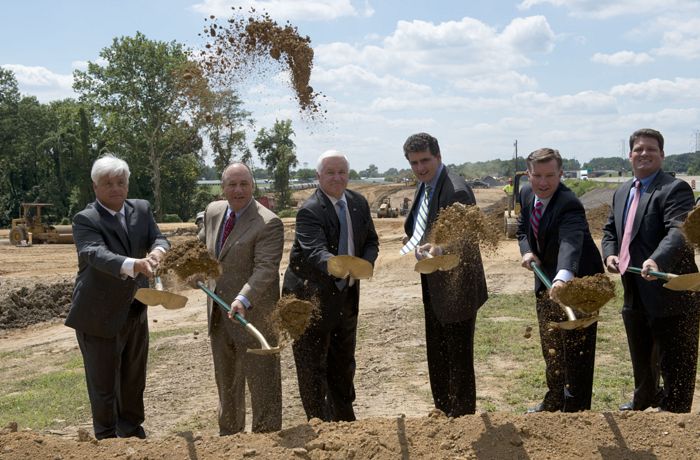
Governor Tom Corbett is joined by local and state
officials for the groundbreaking
(Pennsylvania Commonwealth Media Services)
Construction of the new Open Road Tolling gantry for westbound traffic, utilizing high-speed E-ZPass as well as PA Turnpike TOLL BY PLATE equipment for photographing license plates at highway speed, at the Delaware River Bridge began in June 2013. On January 3, 2016, the new Open Road Tolling facility became the first on the system to be equipped for toll-by-plate technology. Tolls were suspended at the former Delaware River Bridge Toll Plaza as well as at Exit 358, with demolition of both toll plazas occurring during the summer of 2016. Work began in September 2014 on reconstructing and widening the Turnpike from west of the Interstate 95 overpass to west of the Delaware River Bridge Toll Plaza. Also included will be installation of stormwater-management facilities, erosion and sedimentation control measures, and the construction of sound and retaining walls. Roadway improvements to Durham Road and New Rogers Road will also take place. Work on this phase concluded on September 21, 2018 with a ribbon-cutting ceremony at the new interchange, with the ramps connecting Interstate 95 and the Turnpike opening on September 24. The Interstate 95 designation was then changed to cross the Delaware River Bridge into New Jersey and the Interstate 276 designation truncated from the middle of the bridge to the new interchange. The ramps marked the completion of the original Interstate System plan, and marked the first time drivers utilizing Interstate 95 between New York and Philadelphia could do so unimpeded. Project website: http://www.paturnpikei95.com/.
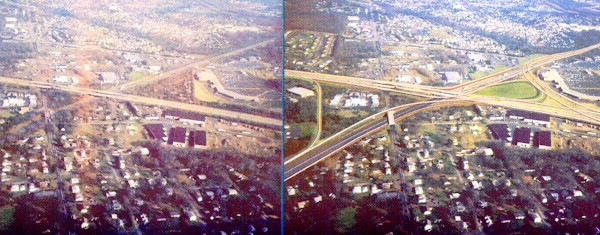
Current I-276/I-95 crossing at the left and
conceptual drawing of the future I-276/I-95
interchange on the right. (Pennsylvania Turnpike Commission)
The over $260 million project was recognized by the Construction Management Association of America's Mid-Atlantic chapter as its Project of the Year for 2018. At the chapter's awards banquet held in
Philadelphia in July 2019, the award in the "Mega Project over $100 million" category was presented to Urban Engineers. We would like to congratulate the Turnpike Commission, PennDOT, and the firms involved in the successful completion
of this dynamic interchange project," said Jerry O’Neill, PE, CCM, senior vice president and general manager for transportation construction services at Urban Engineers. "This is an important project for Southeast Pennsylvania that will
provide more efficient travel for motorists, less congestion to surrounding communities, and growth in the region. We are very proud of our construction management staff who have spent many years working diligently on this project."
Ground was broken on October 14, 2004 for the next widening
project in the Philadelphia area. PTC CEO Joe Brimmeier, PTC Chairman
Mitchell Rubin of Philadelphia, and Vice Chairman Timothy Carson of Montgomery
County led the ceremony on the lawn adjacent to the Norristown Interchange Toll
Plaza. Governor Ed Rendell said commuters will benefit from the $181
million project noting, "This is the most heavily traveled four-lane
section of the PA Turnpike, and it’s located in our state’s most densely
populated region. Renewing and widening this road is vital to improving
the transportation network in the greater Philadelphia area."
Construction involved a total
rebuild and widening to six lanes of a seven mile section from Exit 326/Valley
Forge to Exit 333/Norristown. It was the largest project in the
southeastern Pennsylvania region since the building of the Mid-County
Interchange. Widening work occurred on either side of the Schuylkill
River Bridge, which was already widened to six lanes, with construction beginning on a two mile
section east of the bridge in November 2004 and in Summer 2006 on the five miles from the bridge
west. Bridges in the sections were replaced, such as the US 202 and Flint Hill Road
overpasses along with seven others. The Norristown Interchange was
rebuilt as part of a $14.3 million project to provide 11 new and improved
tollbooths, upgraded E-ZPass lanes, a new fare-collection building, and
reconfigured lanes. Five sound barriers were installed, the shoulder widened from 10 to 12 feet, and the steel median
guide rail replaced by a 52-inch-high Jersey barrier. Work east of the bridge
totaled $29.7 million and was completed on December 22, 2006 while west of the bridge
came in around $158 million and was completed November 21, 2008.
Something travelers who use the
Turnpike did not want to hear happened January 20, 2004. That day the PTC
announced a toll increase of 1.8 cents-per-mile for cars and a 5.3
cents-per-mile increase for trucks which went into effect on August 1, 2004 only
on the mainline and Northeast Extension. The reason for the increase was
to continue to upgrade the highway. Current revenues would take upgrading
the highway 104 years to complete, but with the increase, only 30 years.
Also, widening in locations of bottlenecks, building new ramps, building more
adequate shoulders and sound walls, eliminating dangerous curves, improving
interchanges, and making the E-ZPass system work more smoothly could be achieved
with more revenue. Another hike in tolls, this time 25%, would be instated
on January 4, 2009 for most of the Turnpike System except for Turnpike 43's
Brownsville to Uniontown section and Turnpike 576 where tolls would remain
unchanged. This increase was necessitated by the signage of Act 44 in July
2007 which would provide PennDOT with $450 million a year in supplemental
funding between 2007 and 2057. As part of Act 44, tolls increased 3% a
year later on January 3, 2010 with the exception of
Turnpike 576 again.
Thanksgiving
travelers got an early present on November 24 when toll collectors and
maintenance personnel walked off the job for the first time in 64 years at 4 AM,
forcing the PTC to wave tolls on
the busiest day of the year. No major backups were reported, but traffic
did slow around 5 PM near Exit 57 due to an accident. At the Bedford
Interchange, two truck drivers were citied by State Police after they attempted
to block the toll plaza in a show of solidarity. Teamsters Local 77 and
250 walked off the job due to not receiving raises unlike non-union employees.
The Commission offered a raise of $21 per hour over three years, fully paid
health care package, 15 paid holidays, an average of four weeks of vacation a
year, and a no-layoff clause for three years. The union rejected the
offer, but would not comment on the reason. Around 220 PTC managers were
pushed into service at toll plazas across the state starting at 12:01 AM on
November 25. No tickets were issued and instead a flat rate of $2 for
passenger vehicles and $15 for commercial vehicles. E-ZPass customers were
charged the regular fare up to $2. A
tentative agreement was reached through negotiating sessions that began November
29 at 2:30 PM and ended on November 30 around 10 PM, ending the seven day
strike. Executive Director Joe Brimmeier commended the management employees
who filled in at 36 Turnpike interchanges for "their exemplary service.
These men and women, representing every level of management, performed
magnificently, provided a high level of customer service and ensured the safe
and smooth flow of traffic during the busiest holiday travel period of the year.
I cannot thank them enough for their dedication and commitment." At 9
AM on December 1, tickets began to be reissued and commercial cards accepted.
An eight-hour grace period until 5 AM December 2 was allotted for travelers who
entered the Turnpike when tickets were not being issued. After this
period, they would be charged the lost ticket fare which is the toll from point
of entry to the farthest exit. On April
11, 2005, the PTC announced that the speed limit would be raised to 65 MPH on
100 miles of the Turnpike previously at 55 MPH. Changes to the vehicle
code allowed for the speed to be raised on "urbanized areas" including
Interstate 276's entire length from Exit 326 to Exit 359. The change took
place in May before the always busy Memorial Day weekend. Speed limits
approaching mainline toll plazas will remain at 55 MPH. The
first major snow storm to hit the Commonwealth in 2007 during February 13 and 14
caused something that hasn't happened since the first day of the 2004 collectors
strike: a toll-free, cross-state ride. With accidents, snow, and ice
closing sections of I-78, I-80, and I-81, Governor Rendell declared a statewide
Disaster Emergency on February 15. Part of the declaration included
eliminating tolls beginning at 9:11 PM to provide a free detour route via the
mainline Turnpike and Northeast Extension. Tolls were not reinstated until
February 17 at 8 PM.
Congestion alleviation at the Bensalem and Delaware Valley
Interchanges was aided when the second E-ZPass-only interchange, or All
Electronic Interchange (AEI), opened on November 22, 2010. Construction on
the $7.4 million partial interchange began in May 2009 at milepost 352, where
the South Neshaminy Service Plaza had stood since the opening of the Delaware
River Extension which closed July 30, 2007 and subsequently demolished. It
allows eastbound traffic to exit to PA 132/Street Road and traffic from that
route to enter heading eastbound. The interchange was the culmination of a
partnership between the Turnpike Commission and Bensalem Township, with the
latter managing the design and construction while the former reimbursed the
township for all related costs. The PTC approved a revised fare schedule
for this interchange that went into effect on April 24, 2011 after some
customers questioned the equity of the fare rates. Non-commercial
travelers saw anywhere between a 55 and 88 cent savings.
In what is now a yearly tradition under Act 44, tolls were
raised once again on January 2, 2011; however, not everyone would be paying the
same fare. For the first time, E-ZPass users, who now comprised
approximately two-thirds of Turnpike users, would only see their tolls go up by
3% while cash-paying users would see a 10% increase for an overall increase of
5%. There was controversy over the increase this time, not for the cost of
using the highway, but that the new fares would not be printed on the toll
tickets which had been the case since the Turnpike opened. The Commission
decided that not having to print new tickets every year would save money, but
the traveling public as well as Auditor General Jack Wagner saw it differently.
He was concerned that this practice showed a lack of transparency and made it
appear as if the PTC was trying to hide the hike in tolls and potentially create
a public safety hazard from motorists wanting to have the correct amount before
reaching the toll booth using the Internet to determine their toll.
Officials took exception over Wagner's assertions, but yet decided to reinstate
printing the fare schedule on tickets. The new tickets made it into
circulation by March after the ones without fare schedules were used. Snow and ice played havoc with drivers on the morning of
Valentine's Day 2014. Around 8:30 AM, a 25-car pileup occurred in the
eastbound lanes near Exit 351. When the dust settled, 75 to 100 cars and
tractor trailers were involved and the wreckage stretched westward to Exit
343. Some vehicles that were caught in the backlog were allowed to move
past the pileup while ones involved were beginning to be towed. Late in
the morning on Friday, the westbound lanes were also closed to allow rescuers
access to the scene and crews removed small portions of the Jersey barrier to
allow trapped drivers to U-turn onto the westbound lanes to exit the
Turnpike. Fortunately, there were only 30 reports of injuries and no
deaths. Volunteers from The American Red Cross of Southeastern
Pennsylvania and the Salvation Army brought food, water, and blankets to the
stranded survivors. KYW-TV's traffic reporter Bob Kelly called this
"the worst accident I have seen in the 20 years I have been doing
this." The Turnpike reopened to traffic just before 4 PM, which was
about 7 1/2 hours after the first crash. One of those drivers stranded was
Lynn McNulty, who teaches AP European History at the Hun School in Princeton,
New Jersey. Knowing she would be late, she pulled out her iPad and began
to teach class via the FaceTime application. Severe
weather moved through the state on July 29, 2021 which spawned several
tornadoes. One of them, which was ranked an EF3, touched down in Bucks County near Bensalem, and
after destroying the Faulkner Automotive Group dealerships along PA 132, passed
by the Bensalem Interchange toll plaza where one motorist captured the
experience while stopped in traffic there.
Exit Guide
Interstate 276 Ends
Interstate 276 Pictures
Interstate 280
(Decommissioned)
Pennsylvania
Turnpike
E-ZPass
- Pennsylvania Turnpike Commission
Pennsylvania Turnpike Commission
Pennsylvania Turnpike
Toll/Mileage Calculator
Delaware
River-Turnpike Toll Bridge - Steve Anderson
Interstate 276 - Andy Field/Alex Nitzman
Interstate
276 - David Golub
Interstate 276 - Scott
Oglesby
Interstate
276 Pictures - Steve Alpert
Interstate
276 Pictures - Andy Field/Alex Nitzman
Interstate
276 Photos - Valerie Deane
Pennsylvania Turnpike-Delaware River Extension - Steve
Anderson
 INFORMATION
INFORMATION |
| Western Terminus: | I-76 at Exit 326 in King of Prussia |
| Eastern Terminus: | I-95 and I-295 in Bristol |
| Length: | 30.30 miles |
| National Highway System: | Entire length |
| Names: | Pennsylvania Turnpike East-West Expressway |
| SR Designation: | 7276 |
| Counties: | Montgomery and Bucks |
| Multiplexed Routes: | None |
| Former Designations: | I-80S (1957 - 1958) I-280 (1958 - 1963) |
| Former LR Designations: | None |
| Emergency: | *11 |
 Highway Conditions: |
http://www.paturnpike.com/webmap/ 1-866-976-TRIP |
 Traffic Cameras: |
Valley
Forge (Westbound) Plymouth Meeting (Westbound) Fort Washington (Westbound) Willow Grove (Westbound) Bensalem (Westbound) |
| Advisory Radio: | 1640 AM |